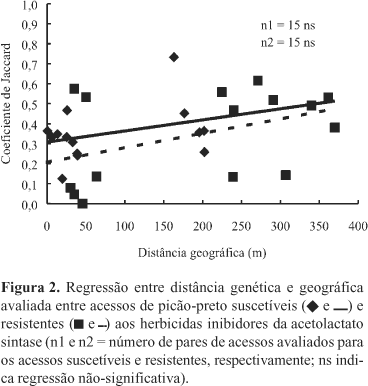The objective of this work was to evaluate the degree of genetic similarity among beggar-ticks accesses, susceptible and resistant to acetolactate sintase (ALS) herbicide inhibitors and the relationship among the genetic similarity and geographic distance of this accesses. Beggar-ticks seeds were sampled at Paraná state and were grown in the greenhouse at Universidade Federal do Rio Grande do Sul, Porto Alegre, RS, Brazil, in October 2004. After the confirmation of resistance or susceptibility to ALS inhibitors herbicides, the DNA extraction was performed. Through RAPD analysis, it was possible to evaluate the genetic similarity among beggar-ticks accesses. In the whole analysis of the accesses, from 20 primers assessed, only 17 displayed polymorphism and amplified a total of 94 bands. Average genetic similarity was low (37%). Regression analysis evidenced that there is no relationship between genetic and geographic distance for the beggar-ticks accesses. Low general similarity among accesses evidences that resistance in the region is represented by selection of resistant individuals already existing in the population.
Bidens pilosa; genetic similarity; resistance; hairy beggar-ticks; RAPD; ALS




